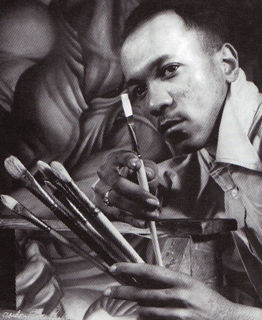 Pictured: from left, sculptor Nathaniel Bustion, art historian Lyn Kienholz, and Ian White at the Pacific Asia Museum, March 25, 2012. Photo: Erika McCarden
Pictured: from left, sculptor Nathaniel Bustion, art historian Lyn Kienholz, and Ian White at the Pacific Asia Museum, March 25, 2012. Photo: Erika McCarden
by Erika McCarden
“It really was such a privilege to be a part of a creative family that inspired social responsibility through many forms," Ian White, son of artist Charles W. White, told the audience at the Pacific Asia Museum in Pasadena on Sunday. "My father was a creative force and impacted many students.”
Ian White took the stage for an intimate Q&A with arts historian Lyn Kienholz for a discussion about Charles W. White and other mid-century Altadena artists.
The gathering served as a tribute to White, who died in 1979 and was deemed one of America's most gifted African-American artists. White’s work touched millions, and depicted the humanity, social justice and human relationships of African Americans.
Before a small crowd of art enthusiasts, former Charles W. White students and fans, Ian discussed his childhood, the racial tension his family encountered and his father’s passion for art in a post Harlem Renaissance era, focused on social consciousness and awareness.
“So many artists and entertainers were always over at our house,” said Ian. “The director Ivan Dixon, who lived at the top of Marengo. Sydney Poitier rented a house out here when he was filming. John Outterbridge, the Watts Towers Director, and Harry Belafonte was a very good friend of my dad’s. In fact, it was Harry that gave my dad the $500 to move to L.A.”
“I’d won a fellowship to Charlie’s workshop,” said Bustion. “I was really blessed to be in his company and watch him talk about creativity, the social consciousness and hysteria behind it. It was an education that I couldn’t get anywhere else on the planet. And, after all of this time, I’m still discovering things in his work.”
 Bustion also shared the struggles White had with being respected and acknowledged as an artist in an era heightened with racial tension.
Bustion also shared the struggles White had with being respected and acknowledged as an artist in an era heightened with racial tension.
“The National Endowment of Arts would have competitions. I remember Charlie would win, but he was always denied the award because he was black,” said Bustion. “His work always sold out at exhibits, and the people who knew he was black feared him showing up.”
“When I told my father I wanted to be an artist, he told me, add more color!” laughed Ian. “My folks were one of the first interracial couples in the community, and the For Sale signs went right up. We ended up moving on Risinghill [Road], where I still live now.”
University of Irvine Professor Ulysses Jenkins, also a former student of White’s, said, “He was such a guiding light for all black students at Otis College, especially at a time when artists weren’t encouraged. His influence certainly went beyond the art galleries.”
When asked about present Altadena in comparison to historic Altadena, Ian said, “I look at Altadena today, and big things are really happening now. The Altadena Arts Council will soon be running art programs at Loma Alta Elementary. Charles White Park now has tutorial services. And new people with new energy are moving into the community, and west Altadena, which is multi-ethnic now.”
The most inspirational moment of the evening came when the personal words of Charles White were spoken in a short film presented to the audience:
“I’ve never said, Oh, my God I have to face another day. I’ve always thought what a thrill it is to live, and what new beauty will come into my life today? What new hope will there be for man?”
PIctured: Charles W. White
-------
We welcome back community journalist Erika McCarden to our stable of Altadenablog writers.



